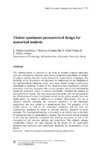Mostrar o rexistro simple do ítem
Timber Specimens Parametrized Design for Numerical Analysis
| dc.contributor.author | Martín-Gutiérrez, Emilio | |
| dc.contributor.author | Estévez-Cimadevila, Javier | |
| dc.contributor.author | Otero-Chans, Dolores | |
| dc.contributor.author | Muñiz Gómez, Santiago | |
| dc.contributor.other | Universidade da Coruña. Departamento de Construcións e Estruturas Arquitectónicas, Civís e Aeronáuticas | es_ES |
| dc.date.accessioned | 2020-11-12T17:50:11Z | |
| dc.date.available | 2020-11-12T17:50:11Z | |
| dc.date.issued | 2006 | |
| dc.identifier.citation | E. Martín Gutierrez, J. Estévez Cimadevila, D. Otero Chans, S. Múñiz Gómez. "Timber specimens parametrized design for numerical analysis".WIT Transactions on The Built Environment, Vol 85. doi:10.2495/HPSM06056 | es_ES |
| dc.identifier.issn | 1743-3509 | |
| dc.identifier.uri | http://hdl.handle.net/2183/26690 | |
| dc.description.abstract | [Abstract] The characterization of materials or the study of resistant response associated with new constructive solutions often convey progressive adjustment of models of analysis starting from the results obtained by means of test campaigns. The reliability of the conclusions will obviously be conditioned by the amplitude of the experimental development which, as a result, should contain a sufficiently representative sampling of cases. In the situations where significantly multiple parameters intervene, specimens that involve possible values and combinations should be examined, which in practice remarkably increases the number of specimens to be treated. The case being presented deals with the evaluation of the effectiveness of certain fixed joints carried out by gluing metallic bars into timber pieces by means of adhesives of different formulations. The set of calculus patterns, including the extensive variability of the associated magnitudes, has been treated in a parametrized form. The geometry of the studied pieces, as well as the sustenance conditions and the load, are automatically generated by means of software specially designed for those purposes. The resulting information is structured in an orderly way to facilitate its reading and also its manipulation if needed. The files of the process obtained in this way can optionally incorporate the meshing sequences, as well as the commands of the calculus, analysis and postprocess. The adopted strategy considerably reduces the time assigned to the phases of the geometrical definition and resolution, and enormously simplifies the interpretation of the results. | es_ES |
| dc.language.iso | eng | es_ES |
| dc.publisher | WIT press | es_ES |
| dc.relation.uri | https://doi.org/10.2495/HPSM06056 | |
| dc.rights | This paper will be freely available, without charge, for users to read, download, copy, distribute, print, search, link to the full text, or use for any other lawful purpose, without asking prior permission from the publisher or the author as long as the author/copyright holder is attributed. WIT Press reserves the right to limit the production of derivative works and commercial exploitation of the Work. Should a third party seek to make a derivative work based on the Work or commercially exploit the Work they must seek permission from WIT Press. | es_ES |
| dc.subject | Numerical analysis | es_ES |
| dc.subject | Parametrized design | es_ES |
| dc.subject | Glued joints | es_ES |
| dc.subject | Analisis númerico | es_ES |
| dc.subject | Diseño parametrizado | es_ES |
| dc.subject | Juntas pegadas | es_ES |
| dc.title | Timber Specimens Parametrized Design for Numerical Analysis | es_ES |
| dc.type | info:eu-repo/semantics/article | es_ES |
| dc.rights.access | info:eu-repo/semantics/openAccess | es_ES |
| UDC.journalTitle | WIT Transactions on The Built Environment | es_ES |
| UDC.volume | 85 | es_ES |
Ficheiros no ítem
Este ítem aparece na(s) seguinte(s) colección(s)
-
GI-GEA - Artigos [62]






